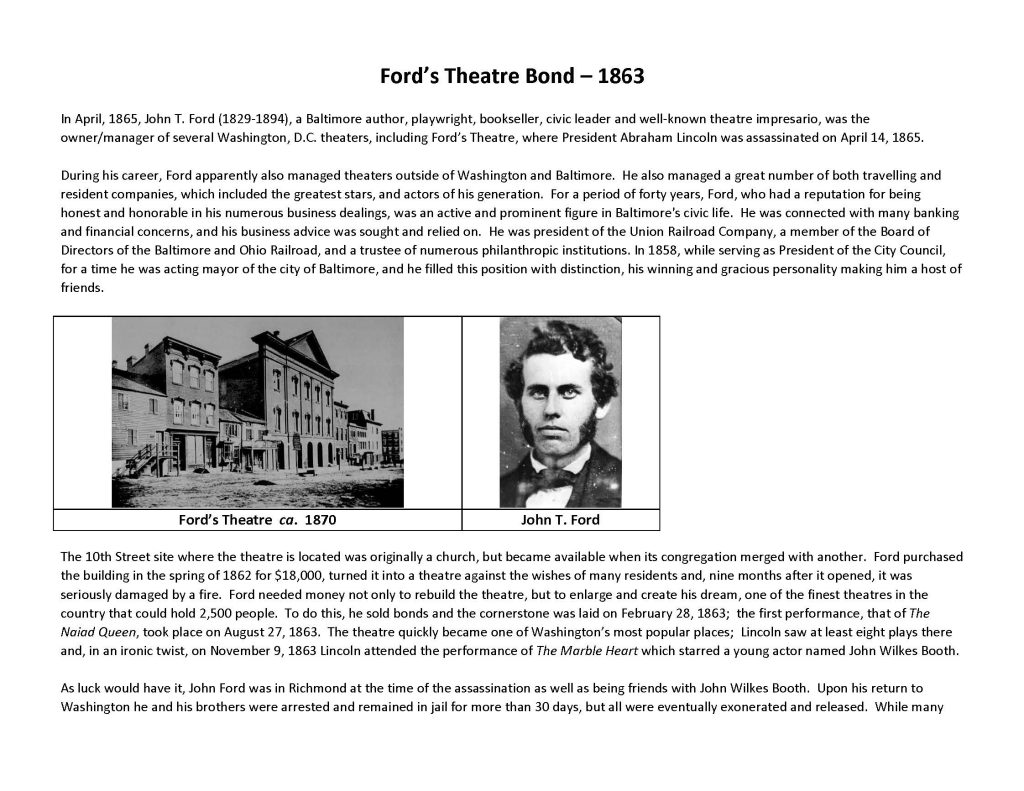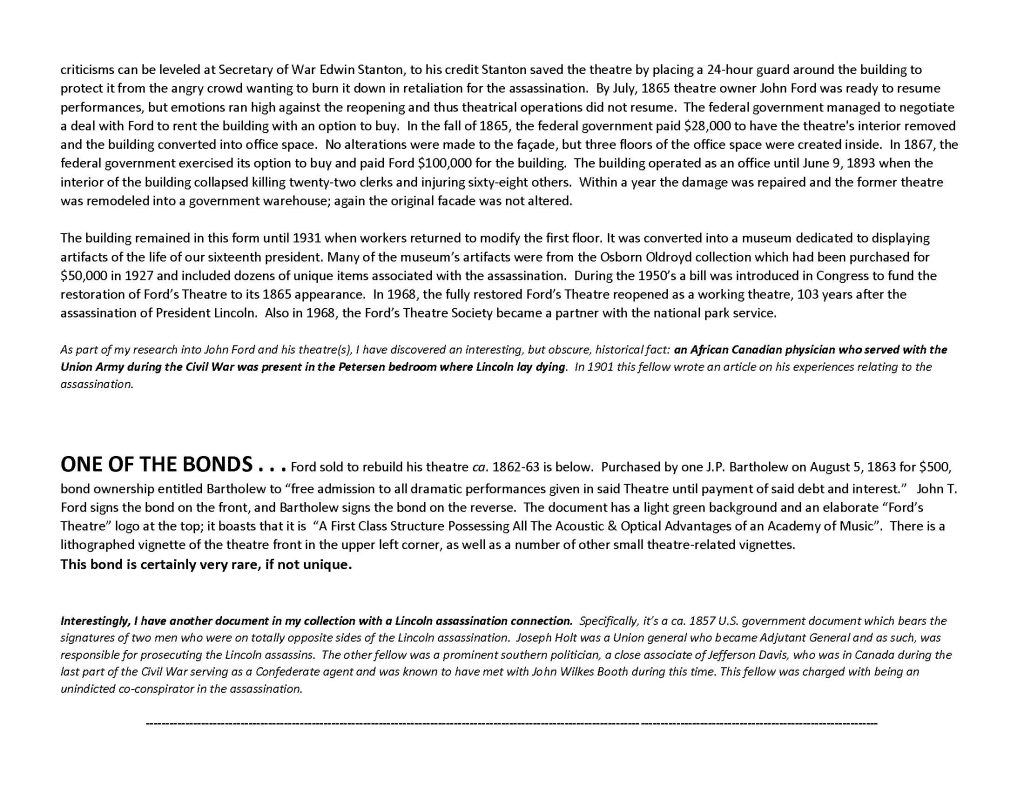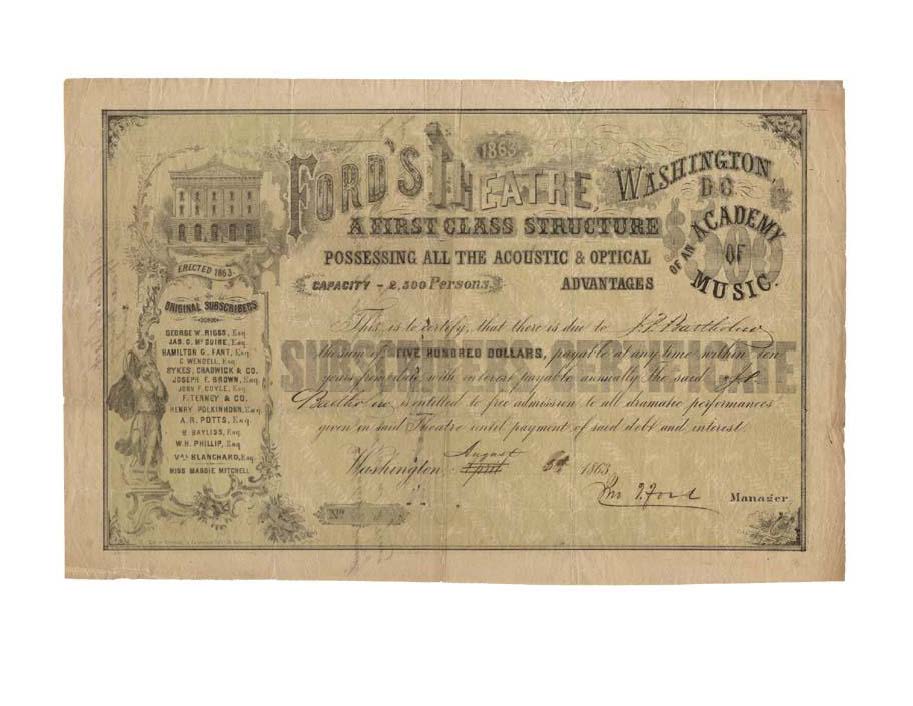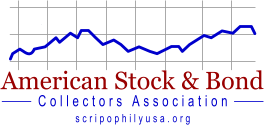Ford’s Theatre Bond – 1863
In April, 1865, John T. Ford (1829-1894), a Baltimore author, playwright, bookseller, civic leader and well-known theatre impresario, was the owner/manager of several Washington, D.C. theaters, including Ford’s Theatre, where President Abraham Lincoln was assassinated on April 14, 1865.
During his career, Ford apparently also managed theaters outside of Washington and Baltimore. He also managed a great number of both travelling and resident companies, which included the greatest stars, and actors of his generation. For a period of forty years, Ford, who had a reputation for being honest and honorable in his numerous business dealings, was an active and prominent figure in Baltimore’s civic life. He was connected with many banking and financial concerns, and his business advice was sought and relied on. He was president of the Union Railroad Company, a member of the Board of Directors of the Baltimore and Ohio Railroad, and a trustee of numerous philanthropic institutions. In 1858, while serving as President of the City Council, for a time he was acting mayor of the city of Baltimore, and he filled this position with distinction, his winning and gracious personality making him a host of friends.
|
Ford’s Theatre ca. 1870 |
John T. Ford |
The 10th Street site where the theatre is located was originally a church, but became available when its congregation merged with another. Ford purchased the building in the spring of 1862 for $18,000, turned it into a theatre against the wishes of many residents and, nine months after it opened, it was seriously damaged by a fire. Ford needed money not only to rebuild the theatre, but to enlarge and create his dream, one of the finest theatres in the country that could hold 2,500 people. To do this, he sold bonds and the cornerstone was laid on February 28, 1863; the first performance, that of The Naiad Queen, took place on August 27, 1863. The theatre quickly became one of Washington’s most popular places; Lincoln saw at least eight plays there and, in an ironic twist, on November 9, 1863 Lincoln attended the performance of The Marble Heart which starred a young actor named John Wilkes Booth.
As luck would have it, John Ford was in Richmond at the time of the assassination as well as being friends with John Wilkes Booth. Upon his return to Washington he and his brothers were arrested and remained in jail for more than 30 days, but all were eventually exonerated and released. While many criticisms can be leveled at Secretary of War Edwin Stanton, to his credit Stanton saved the theatre by placing a 24-hour guard around the building to protect it from the angry crowd wanting to burn it down in retaliation for the assassination. By July, 1865 theatre owner John Ford was ready to resume performances, but emotions ran high against the reopening and thus theatrical operations did not resume. The federal government managed to negotiate a deal with Ford to rent the building with an option to buy. In the fall of 1865, the federal government paid $28,000 to have the theatre’s interior removed and the building converted into office space. No alterations were made to the façade, but three floors of the office space were created inside. In 1867, the federal government exercised its option to buy and paid Ford $100,000 for the building. The building operated as an office until June 9, 1893 when the interior of the building collapsed killing twenty-two clerks and injuring sixty-eight others. Within a year the damage was repaired and the former theatre was remodeled into a government warehouse; again the original facade was not altered.
The building remained in this form until 1931 when workers returned to modify the first floor. It was converted into a museum dedicated to displaying artifacts of the life of our sixteenth president. Many of the museum’s artifacts were from the Osborn Oldroyd collection which had been purchased for $50,000 in 1927 and included dozens of unique items associated with the assassination. During the 1950’s a bill was introduced in Congress to fund the restoration of Ford’s Theatre to its 1865 appearance. In 1968, the fully restored Ford’s Theatre reopened as a working theatre, 103 years after the assassination of President Lincoln. Also in 1968, the Ford’s Theatre Society became a partner with the national park service.
As part of my research into John Ford and his theatre(s), I have discovered an interesting, but obscure, historical fact: an African Canadian physician who served with the Union Army during the Civil War was present in the Petersen bedroom where Lincoln lay dying. In 1901 this fellow wrote an article on his experiences relating to the assassination.
ONE OF THE BONDS . . . Ford sold to rebuild his theatre ca. 1862-63 is below. Purchased by one J.P. Bartholew on August 5, 1863 for $500, bond ownership entitled Bartholew to “free admission to all dramatic performances given in said Theatre until payment of said debt and interest.” John T. Ford signs the bond on the front, and Bartholew signs the bond on the reverse. The document has a light green background and an elaborate “Ford’s Theatre” logo at the top; it boasts that it is “A First Class Structure Possessing All The Acoustic & Optical Advantages of an Academy of Music”. There is a lithographed vignette of the theatre front in the upper left corner, as well as a number of other small theatre-related vignettes.
This bond is certainly very rare, if not unique.
Interestingly, I have another document in my collection with a Lincoln assassination connection. Specifically, it’s a ca. 1857 U.S. government document which bears the signatures of two men who were on totally opposite sides of the Lincoln assassination. Joseph Holt was a Union general who became Adjutant General and as such, was responsible for prosecuting the Lincoln assassins. The other fellow was a prominent southern politician, a close associate of Jefferson Davis, who was in Canada during the last part of the Civil War serving as a Confederate agent and was known to have met with John Wilkes Booth during this time. This fellow was charged with being an unindicted co-conspirator in the assassination.







